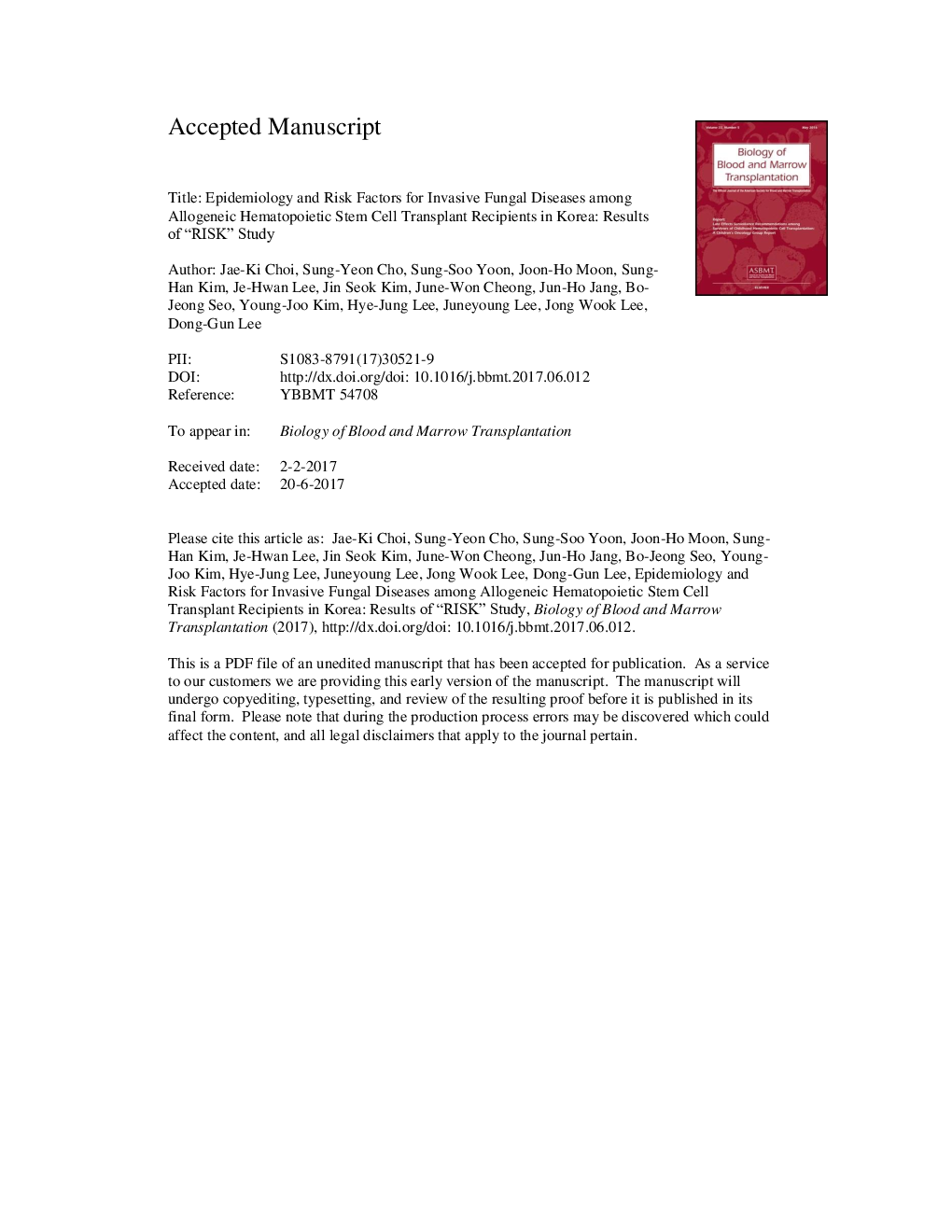| کد مقاله | کد نشریه | سال انتشار | مقاله انگلیسی | نسخه تمام متن |
|---|---|---|---|---|
| 5524065 | 1546236 | 2017 | 24 صفحه PDF | دانلود رایگان |
عنوان انگلیسی مقاله ISI
Epidemiology and Risk Factors for Invasive Fungal Diseases among Allogeneic Hematopoietic Stem Cell Transplant Recipients in Korea: Results of “RISK” Study
ترجمه فارسی عنوان
اپیدمیولوژی و عوامل خطر ابتلا به بیماری های قارچی کشنده در میان گیرندگان پیوند سلول های بنیادی هموگلوبین خون در کره: نتایج یک تحقیق مطالعه
دانلود مقاله + سفارش ترجمه
دانلود مقاله ISI انگلیسی
رایگان برای ایرانیان
کلمات کلیدی
پیوند سلول بنیادی هماتوپوئیت، مایکوئوس، همهگیرشناسی، عوامل خطر، جمهوری کره،
موضوعات مرتبط
علوم زیستی و بیوفناوری
بیوشیمی، ژنتیک و زیست شناسی مولکولی
تحقیقات سرطان
چکیده انگلیسی
Incidence, epidemiology, and risk factors of invasive fungal diseases (IFDs) in allogeneic hematopoietic stem cell transplant (allo-HSCT) recipients can vary from different cohorts and countries. Therefore, we performed a nationwide study to establish a proper antifungal prophylaxis strategies based on risk stratifications of IFDs after all-HSCT in Korea (RISK study). This was a multicenter, retrospective, and observational study in Korea. All consecutive adult patients who received allo-HSCT in 2013 were included. The 12-month cumulative incidence of proven/probable IFDs (PP-IFDs) was calculated during the early (days 0 to 40), late (days 41 to 100), and very late (days 101 to 365) phases after allo-HSCT. Cox proportional hazard regression analysis was performed to identify risk factors for PP-IFDs at each phase. A total 521 allo-HSCT cases in 518 patients were analyzed. Overall cumulative incidence of PP-IFDs were 4.09% (95% confidence interval [CI], 2.38 to 5.81), 7.38% (95% CI, 5.09 to 9.67), and 15.36% (95% CI, 12.04 to 18.68) at the early, late and very phases, respectively. In multiple Cox regression analysis, variables were associated with PP-IFDs in each period were identified. Variables associated with early phase include underlying pulmonary diseases, underlying nonmalignant stable or chronic disease at allo-HSCT, unrelated or family mismatched donor, and prolonged neutropenia. Variables associated with the late phase include high ferritin level at the time point of allo-HSCT, use of secondary immunosuppressive agents due to refractory graft-versus-host disease (GVHD), and cytomegalovirus reactivation. For the very late phase, variables were secondary neutropenia, severe chronic GVHD, and use of TNF-alpha inhibitor for refractory GVHD. This study revealed the high cumulative incidence of IFDs in Korean allo-HSCT recipients, which have distinct risk factors in each phase after allo-HSCT. Our findings indicate that tailored antifungal prophylaxis is necessary for high-risk patients. Clinicians should consider using mold-active antifungal prophylaxis in allo-HSCT recipients who have high risks at different treatment period.
ناشر
Database: Elsevier - ScienceDirect (ساینس دایرکت)
Journal: Biology of Blood and Marrow Transplantation - Volume 23, Issue 10, October 2017, Pages 1773-1779
Journal: Biology of Blood and Marrow Transplantation - Volume 23, Issue 10, October 2017, Pages 1773-1779
نویسندگان
Jae-Ki Choi, Sung-Yeon Cho, Sung-Soo Yoon, Joon-Ho Moon, Sung-Han Kim, Je-Hwan Lee, Jin Seok Kim, June-Won Cheong, Jun-Ho Jang, Bo-Jeong Seo, Young-Joo Kim, Hye-Jung Lee, Juneyoung Lee, Jong Wook Lee, Dong-Gun Lee,
